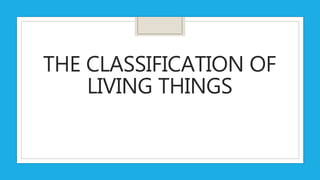
The classification of living things
- 1. THE CLASSIFICATION OF LIVING THINGS
- 2. The classification of animals ◦ Animals are multicelular and we have two types. Vertebrates (with SPINAL COLUMN) and invertebrates (without spinal column). InvertebratesVertebrates 1. MAMMALS 2. REPTILES 3. FISH 4. BIRDS 5. AMPHIBIANS 1. MOLLUSC 2. COELENTERATES 3. PORIFERA 4. ECHINODERMS 5. ARTHROPODS 6. ANNELIDS
- 3. LET’S SEE A VIDEO!!
- 4. VERTEBRATES: MAMMALS ◦ They have lungs to breathe. ◦ Usually they have four legs but sometimes they walk on two legs. ◦ Their SKIN is covered with hair called FUR. ◦ Aquatic mammals have FINS for swimming. ◦ They have a TAIL. ◦ Almost mammals are VIVIPAROUS.
- 5. VERTEBRATES: REPTILES ◦ In their bodies they have SCALES to protect their bodies but some of them have a hard SHELL. ◦ Respiration through lungs. ◦ Four legs except snakes that don’t have legs. ◦ They are OVIPAROUS, this means they are born from eggs.
- 6. LET’S WORK! EXERCISE 1. Make two columns (MAMMALS, REPTILES) and put these characteristics in them. FUR OVIPAROUS FOUR LEGS A TAIL LUNGS SCALES SHELL VIVIPAROUS MAMMALS REPTILES
- 7. VERTEBRATES: FISH ◦ Body covered by scales. ◦ Respiration through GILLS that get OXYGEN from water. ◦ They use their fins and tails to swim through the water. ◦ They are oviparous.
- 8. VERTEBRATES: BIRDS ◦ They are oviparous. ◦ Respiration through lungs. ◦ They have two wings and two legs. Their body is AREODYNAMIC, that means the bones have a lot of space to make them easier to fly. ◦ They are oviparous.
- 9. VERTEBRATES: AMPHIBIANS ◦ They have four legs. ◦ They are oviparous. ◦ The respiration when they are young is through gills in wáter but when they are adults they take oxygen through lungs. ◦ Their skin is thin and SMOOTH.
- 10. LET’S WORK TOGETHER! ◦In groups, each classmate draw ONE animal from each vertebrate group and write down the main characteristics. Then make a poster and explain your poster.
- 12. INVERTEBRATES They are animals that do not have SPINAL CORD. 1.MOLLUSC 2.COELENTERATES 3.PORIFERA 4.ECHINODERMS 5.ARTHROPODS 6.ANNELIDS
- 13. INVERTEBRATES: MOLLUSCS COELENTERATES ◦ Molluscs: they have soft bodies and a hard Shell. They breathe through gills and reproduce by eggs. Examples: MUSSELS, SNAILS, OYSTERS. ◦ Coelenterates: they have a soft body and some with long TENTACLES. They absorb oxygen through their skin. They reproduce by growing a BUD. Examples JELLYFISH
- 14. INVERTEBRATES: PORIFERA ECHINODERMS ◦ Porifera: they have holes called PORES to absorb oxygen and nutrients through them. They reproduce by forming buds. Example: SPONGES. ◦ Echinoderms: theis bodies are covered with Sharp SPIKES and some have TENTACLES. They use gills to breathe and some breathe through their skin. Example: STARFISH.
- 15. INVERTEBRATES: Arthropods - Annelids ◦ Arthropods: they have an EXOSKELETON that can BEND. They are oviparous and some of then breathe through lungs and other through gills. Example, crabs and lobsters. ◦ Annelids: they have a long soft body divided in SEGMENTS. They absorb oxygen through their skin. They can reproduce by BUDDING but some are oviparous. Example, worms.
- 16. Let’s work! Exercise 2. Write on your notebook what kind of invertebrate and the main characteristis of these animals. A B C Example: Picture A is …… and its characteristics are….
- 17. THE CLASSIFICATION OF PLANTS: SEED PLANTS Reproduce by creating seeds. According to this we have two types of seed plants. Flower plants They are called FLOWERING PLANTS because they grow flowers. Fruits grow from flowers and the sedes grow inside. Example, apple tree, orange tree. Conifers They produce CONES, where the seeds grows. Example, pine tree
- 18. THE CLASSIFICATION OF PLANTS: Non- seed plants ◦ They are plants that produce cells called SPORES. They fall to the grounds and they grow into plants. There are two types: Ferns Their leaves are called fronds. They have roots to absorb nutrients from the soil. Mosses Don’t have roots. They use their RHIZOIDS, stem and leaves to absorb water and nutrients
- 19. LET’S WORK! EXERCISE 3. Copy these sentences and say if they are TRUE or FALSE. Then correct the false sentences. 1. Flowering plants don’t have fruits. 2. Trees that have cones are called flowering plants. 3. We have two types of plants: seed plants and non-seed plants. 4. Ferns obtain wáter and nutrients through seeds. 5. Mosses don’t produce special cells called spores.
- 20. LET’S INVESTIGATE! ◦Find a tree in your Street and take a picture or draw it. ◦Put it in your notebook and write its name and characteristics. ◦Then, explain it in class.
- 21. FINAL TASK! ◦ In groups you are going to prepare seven questions about what we have seen in this unit. ◦ Discuss in groups and write the questions and answers. ◦ Questions MUST BE in English and answers in Spanish. ◦ After finishing all groups, the teacher will select 15 questions. You will have to study them and get ready for an exam.
- 22. GOOD LUCK!